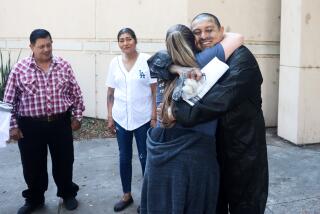All ‘Twilight Zone’ Figures Acquitted : Jurors Clear Director Landis and 4 Others of Manslaughter Charges
A Los Angeles Superior Court jury, taking only one round of balloting after a stormy 10-month trial, found film director John Landis and four associates not guilty Friday of involuntary manslaughter charges stemming from the 1982 deaths of actor Vic Morrow and two children on the set of the “Twilight Zone.”
“We believe this was all an unforeseeable accident--you don’t prosecute people for unforeseeable accidents,” jury foreman Lois Rogers, a North Hollywood homemaker, told a courtroom press conference as the beaming defendants looked on.
Minutes earlier, as the court clerk intoned the 15 identical verdicts to a packed, silent courtroom, Landis dabbed his eyes with a handkerchief. The 36-year-old director then turned toward the jurors and grinned. Judge Roger W. Boren declared, “The defendants are discharged,” and several of Landis’ family members and supporters, led by director Michael Ritchie, broke into loud applause.
‘Tragic Accident’
“A truly terrible, tragic accident happened on the set of the “Twilight Zone.” I’m very relieved, but I feel very sorry for the families of the children,” Landis said, speaking haltingly to reporters. “I feel extremely grateful to the jury for their common sense and patience.”
Landis and his wife, Deborah, hugged each of the jurors before they departed.
The prosecutor in the closely watched Hollywood case, Deputy Dist. Atty. Lea Purwin D’Agostino, left the courtroom without waiting to speak to the mostly blue-collar jury. D’Agostino, who looked ashen-faced as the verdicts were read, said later she was “shocked” at the verdict and added that she still believed that the evidence of criminal negligence “was overwhelming.”
“If nothing else,” D’Agostino said, “hopefully this prosecution has made other directors more cautious.”
Negligence Charged
The five defendants were accused of acting with criminal negligence in the July, 1982, deaths of the three actors, who were struck and killed by a combat-style Huey UH-1B helicopter during the late-night filming of a mock Vietnam battle scene at rustic Indian Dunes Park near Saugus.
According to D’Agostino, the accident was the first ever in which young children were killed on a Hollywood film set. And Landis is the only Hollywood director ever to have been criminally charged for deaths on a set, authorities said.
Yet the trial seemed to produce as much histrionics as history, with the team of seven defense attorneys incessantly swapping insults with the prosecutor, and with D’Agostino herself labeling Landis a “master puppeteer” and a “tyrannical dictator.”
The 12 jurors, who deliberated for nine days, arrived at their decision after their very first round of balloting Friday morning. A day earlier, they had viewed videotaped footage of the accident on a television monitor installed in the jury room. About half of their 32 hours of deliberations was spent listening to a rereading of testimony from four witnesses.
“We wanted to be absolutely sure (before balloting),” Rogers said at the unusual courtroom press conference, in which the jurors sat in their usual seats in the jury box. “We were going to stick to the facts and evidence. . . . We didn’t want personalities (to intrude).”
Smiles, Cheers
As the jurors explained their verdicts, the defendants and their lawyers, looking on from their own customary seats at the defense table, smiled and cheered.
“When I’m back in Tennessee,” concluded Landis’ Nashville-based attorney James Neal, a former Watergate prosecutor, “whenever anybody talks to me about Southern hospitality, I will think of Southern California. Thank you.”
Landis, the director of such box office comedy hits as “Animal House” and “Trading Places,” was accused of criminal negligence and child endangerment and had faced a maximum prison sentence of six years on five counts of involuntary manslaughter. Helicopter pilot Dorcey Wingo and special-effects coordinator Paul Stewart, both charged with three counts based on criminal negligence on the film set, also faced maximum six-year prison terms.
Associate producer George Folsey Jr. and unit production manager Dan Allingham, charged with two counts stemming from the illegal hiring of the children, both faced maximum five-year sentences.
“You don’t charge people for an industrial accident,” a relieved Folsey said. “She (D’Agostino) had no case at all . . . except for a scary-looking film that was designed to look dangerous.”
Folsey’s wife, Belinda, who had attended the trial each day, clutched their daughter Erin and said, “Thank God that they understood it was a terrible accident. It’s been a long time.”
Still not settled, however, are civil lawsuits that were filed by the families of the two dead children, Renee Chen, 6, and Myca Dinh Lee, 7.
Suit Will Proceed
Ned Good, an attorney for the Lee family, said the suit would “absolutely go forward. The defendants are clearly guilty of negligence. Whether or not their conduct is criminally negligent requires a greater burden of proof.”
Neither the Chen nor Lee families would comment on the verdict, their lawyers said.
The script of “Twilight Zone: The Movie” had called for Morrow to heroically carry the children across the Santa Clara River, away from the pursuing helicopter, and utter the final lines: “I’ll keep you safe, kids. I promise. Nothing will hurt you, I swear to God.”
But instead, as more than 100 film crew members and visitors stared in horror, film illusion was shattered when the three-ton helicopter careened out of the sky after its tail rotor was engulfed by the blazing fireball of a special-effects explosive.
Chen was crushed by the helicopter. Morrow, 53, and Lee were decapitated by the 44-foot-long main rotor blade.
War Film Veteran
Much of Morrow’s 27-year acting career had been spent in war films. He gained his greatest fame as a grizzled Army sergeant in the television series “Combat.” Among his screen credits were “Blackboard Jungle,” “God’s Little Acre” and “The Bad News Bears.”
Neither the fatal scene nor any reference to the children was included in the film. However, the repercussions of the accident still reverberate through the film community.
In strict legal terms, the defendants were charged with having displayed wanton and reckless disregard for human life.
Common Sense Issue
Yet despite the length of the trial, D’Agostino had argued, the key issue boiled down to basic common sense. It does not take a genius, she said, to realize that it is unsafe to place actors close to a helicopter hovering at 24 feet in the vicinity of special-effects explosives that fire more than 100 feet into the air.
The defense countered that the tragedy was not criminal in nature, but rather an unfortunate accident resulting from “unforeseen and unforeseeable” circumstances. In essence, the defense pinned the blame on a special-effects crew member who ignited the fatal explosives without looking up at the helicopter.
Landis, Folsey and Allingham had admitted long before the trial that they illegally hired the children without a needed state permit. However, the district attorney’s office did not charge them with that, nor would it accept an offer by the defense to have the three plead guilty to the illegal hiring.
After the verdict, Los Angeles County Dist. Atty. Ira Reiner, who had rejected the offer, called it “a complex case with very serious consequences. We felt there was reckless conduct. . . . We’re in business here to try cases. We win most of them; we lose a few,” he said.
By the time jurors finally began their deliberations, they had heard 93 days of testimony, followed by four days of prosecution rebuttal and 13 days of final arguments.
In 71 days of prosecution testimony, the fiery D’Agostino called 71 witnesses, ranging from the parents of the dead children to expert helicopter pilots and well-known actor-director Jackie Cooper. She also called dozens of “Twilight Zone” film crew members, several of whom supported the accounts of Landis and his associates.
Parents Testify
The most dramatic testimony came from the youngsters’ parents, who charged that Folsey and Landis had never informed them that their children, who had never acted before, would be filmed near special-effects explosions and a low-flying helicopter.
“(Folsey) said he would treat them like his own children,” Mark Chen recalled, sobbing uncontrollably on the witness stand. Chen said that he and his wife had agreed to allow their only child to be in the movie because “when she grew up she would have a lot of memories of what she had done.”
Another key prosecution witness was one-time “Our Gang” member Cooper, who testified: “The proximity of the aircraft to the size of the (special-effects) explosions I saw, in my opinion, looked very unsafe.”
Cooper, then the chairman of the Directors Guild of America’s safety committee, also questioned Landis’ judgment. Emphasizing that explosives had also been ignited too close to the helicopter in a similar sequence shot only three hours before the tragedy, Cooper, raising his voice, said, “Almost any director that I know and respect, and I myself, after (that) incident . . . would have sent the company home.”
Film crew members called to testify by D’Agostino included camera operators, Stewart’s four special-effects employees, the script supervisor, hair stylist, stunt men, location manager and production office personnel.
‘May Lose the Helicopter’
Several told jurors of eye-opening statements allegedly made by Landis before the accident. Cameraman Stephen Lydecker swore he warned Landis of the dangers of filming the fatal scene, to which Landis replied, “We may lose the helicopter.”
According to another witness, Landis told a second cameraman who expressed concern, “If (he) didn’t want to do the shot, he could go home and (Landis) would do it instead.”
And Landis allegedly joked to crew members about the problems that arose in the earlier filming sequence: “You haven’t seen nothing yet.”
D’Agostino’s case also was highlighted by three field trips: to Indian Dunes, to Warner Bros. Hollywood studio and to the Academy of Motion Picture Arts and Sciences in Beverly Hills. The latter two trips were for viewings of the searing footage of the fatal accident, shot from six different camera angles.
Five times, the jurors observed the gruesome image of a huge helicopter spinning crazily out of control--with no trace of the three actors visible after the aircraft came to rest in the river.
The defense case was presented in 22 days, with testimony from 16 witnesses, including Landis and Wingo, both of whom staunchly defended their actions.
Landis emphatically told jurors that he still believed that the fatal scene was not inherently dangerous, even though, as a result of the tragedy, he would never try it again.
In addition, the director maintained that a series of preflight production meetings were held to coordinate the sequence and to handle any safety concerns. During his four days on the witness stand, Landis also directly contradicted the testimony of more than a dozen prosecution witnesses, including Lydecker and the parents of the deceased children.
For example, the director said he described the fateful scene to the parents--a contention they denied.
Pilot Wingo took the stand against the advice of attorneys for the other defendants in order to tell jurors that he never worried that the sequence would prove unsafe. Wingo said he was “distressed to the max” that Morrow did not try to elude the plummeting copter.
Explains Memory Gaps
By agreeing to tell his side, Wingo was also forced to answer a barrage of prosecution questions concerning statements he had made to investigators shortly after the crash that contradicted his trial testimony. Backed by the testimony of an expert psychiatrist, Wingo explained that he had suffered memory gaps following the accident and had thus been unable previously to recall such details as the preflight meetings that Landis maintained took place.
Defense lawyers also relied heavily on their cross-examination of one of D’Agostino’s witnesses, special-effects technician James Camomile.
It was Camomile, granted immunity by the prosecution, who triggered the mortars that knocked Wingo’s helicopter from the sky. Camomile acknowledged that he did not look up from his firing board as he should have before igniting the blasts. Pressed further, Camomile admitted it was his responsibility to be sure that conditions were safe before he fired.
In a particularly bizarre twist, the other key defense witness was Deputy Dist. Atty. Gary P. Kesselman, the prosecutor who had shepherded the case through the grand jury and preliminary hearing stages.
Kesselman, subpoenaed by the defense last September, testified that he did not recall ever being told by D’Agostino’s first witness, production secretary Donna Schuman, that she had overheard Landis and Folsey joke about going to jail for illegally hiring the child actors.
He also denied that he had ever told Schuman that he intended to deliberately withhold such statements from the defense before the trial. Kesselman eventually testified before the jury that D’Agostino had pressured him to support Schuman’s testimony.
“I said to her, if she was even implying or insinuating that I would commit perjury in this case, she had the wrong guy,” Kesselman recalled having said during cross-examination by a third deputy district attorney, who was called in to avoid a conflict of interest.
D’Agostino, without the jury present, also took the highly unusual step of taking the witness stand herself, to back Schuman over Kesselman. But Judge Boren denied a request from D’Agostino to explain her side with jurors present.
The lengthy trial was further spiced by an unrelenting barrage of insults that the seven defense lawyers and D’Agostino hurled at each other, mostly outside the courtroom.
At one point, Folsey’s attorney, Harland Braun, told reporters that D’Agostino was “scum.” She retorted that Braun would call his mother a liar if it would help him win the case. Stewart’s lawyer, Arnold L. Klein, also picked on D’Agostino, comparing her IQ to that of a radish.
Target of Acrimony
Judge Boren eventually became a target of acrimony, too, when he refused to investigate defense charges of a prosecution cover-up concerning the Kesselman affair. Speaking directly to the judge, an angered Braun asked Boren whether he was more like Pontius Pilate than Watergate Judge John Sirica. “Very good Mr. Braun, I think you’re ridiculous,” Boren replied.
At times, the “Twilight Zone” trial took on a glitzy Hollywood air, with a slew of celebrities trekking to Department 132 of the Criminal Courts Building to show their support for Landis.
In a case with more than its share of surprises, one of the odder interludes occurred when D’Agostino subpoenaed octogenarian actor Ralph Bellamy as a trial witness.
Her action came in reaction to Bellamy’s statements outside court that Landis was “being persecuted. . . . There is a theatricality to this.” If Bellamy was going to make such allegations, D’Agostino said, he should get up on the witness stand and say it to the jury.
Boren, though, quickly quashed the subpoena.
Whose Tears Were Real?
Then there was the issue of whose tears were the most real--D’Agostino’s or Landis’.
When Landis became misty-eyed on the witness stand, D’Agostino twice offered him a Kleenex. He declined. Later, outside court, she asserted that the lead defendant’s performance was “perfectly orchestrated” and that he deserved an Oscar.
After resting her case, the prosecutor broke down outside the courtroom while discussing the actors’ deaths with reporters. The acerbic Braun immediately dubbed D’Agostino’s declarations “an act . . . part of her aborted starlet career.”
More to Read
Only good movies
Get the Indie Focus newsletter, Mark Olsen's weekly guide to the world of cinema.
You may occasionally receive promotional content from the Los Angeles Times.









